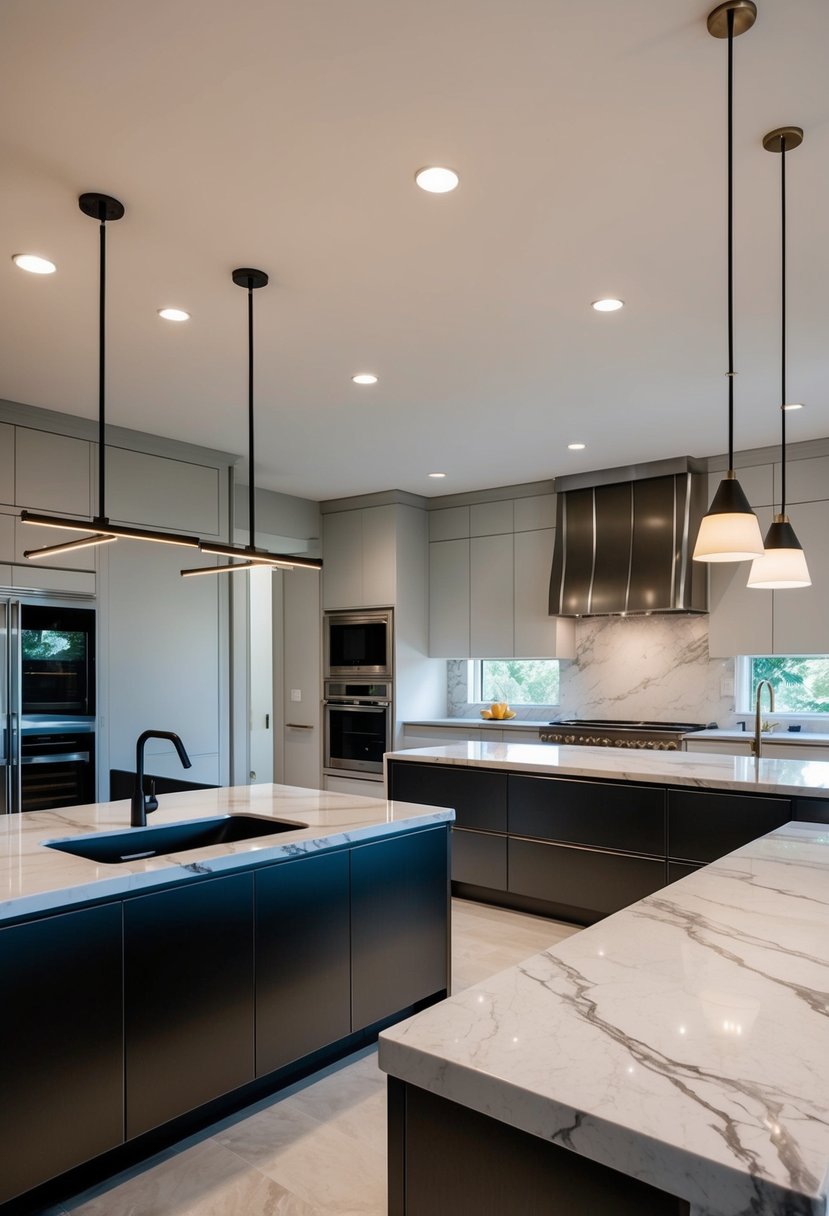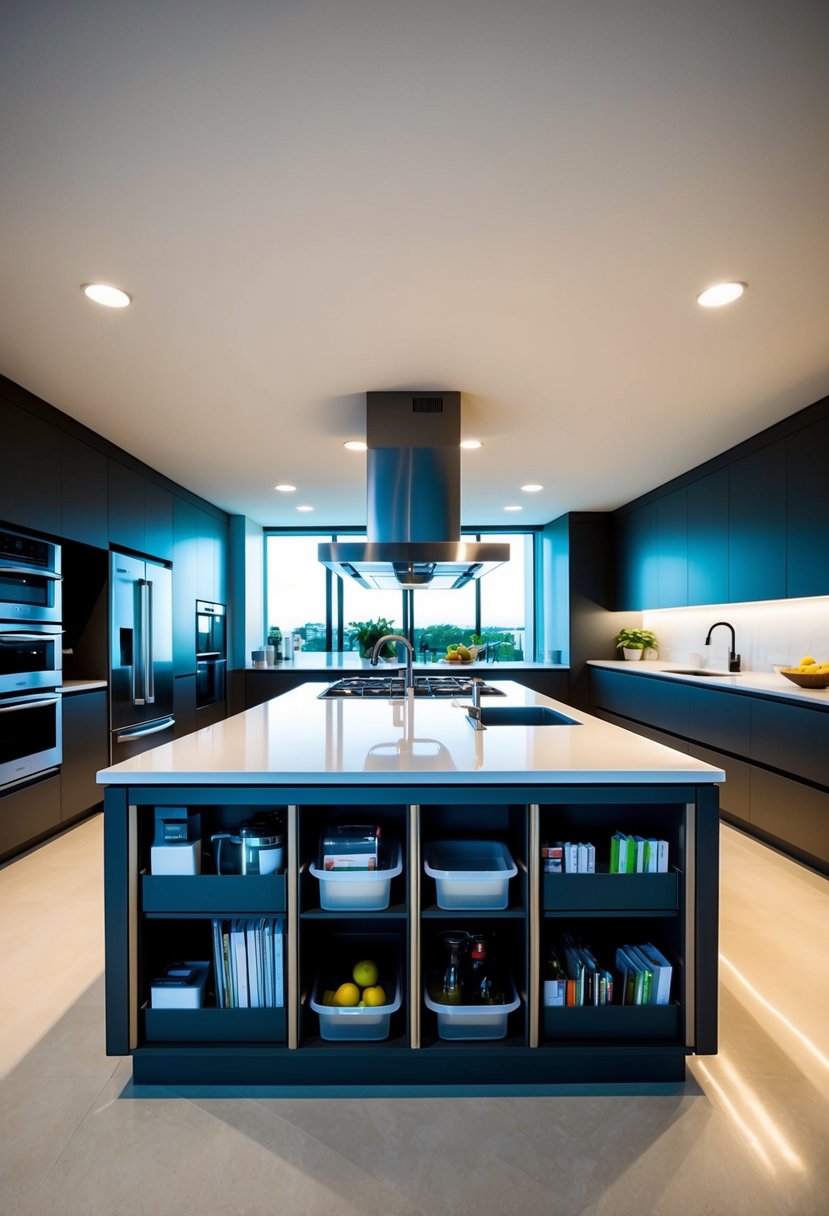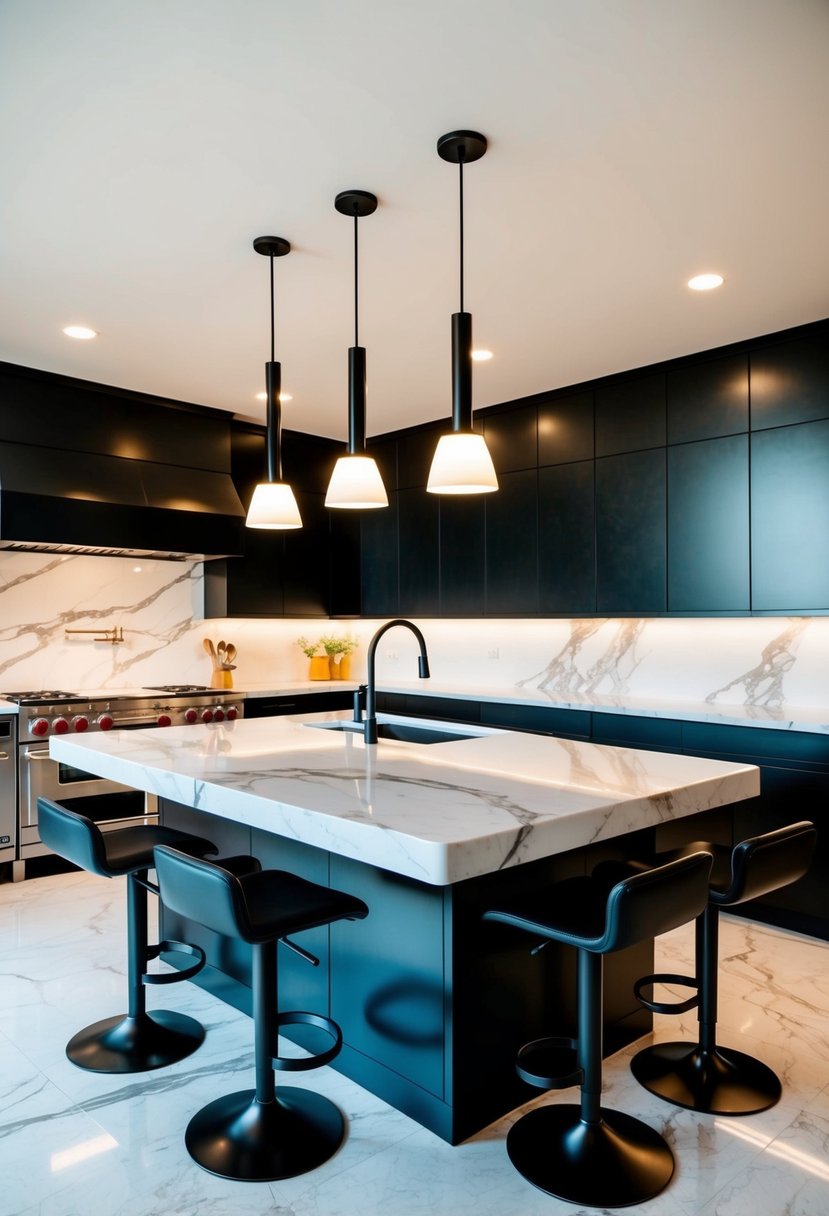Kitchen Islands Design Transforming your Home
A kitchen island is a versatile piece of furniture that adds extra countertop space and storage to any kitchen. It can serve as a prep area, dining spot, or even a place to gather with family and friends. A well-chosen kitchen island improves both the function and flow of the kitchen.

A kitchen island is more than just extra counter space—it’s a functional centerpiece that can transform your kitchen’s workflow and style.
Available in a wide range of styles and sizes—from compact rolling carts to full-size built-in islands—these versatile additions can be tailored to fit any kitchen layout. Materials like wood, butcher block, and metal offer plenty of options to complement both modern and traditional designs.
Beyond aesthetics, kitchen islands provide valuable storage, added prep space, and a natural gathering spot for guests or family. Whether you’re looking for something space-saving or a bold statement piece, there’s a perfect island out there to suit your needs. Explore stylish, functional options from top retailers like IKEA or The Home Depot to find the right match for your kitchen.
Understanding Kitchen Islands

Kitchen islands add useful counter space, storage, and often seating to the kitchen area. They are designed to be accessible from all sides, making kitchen tasks easier and more efficient.
Definition and Purpose
A kitchen island is a standalone unit that sits in the center or main area of a kitchen. It can be a countertop, cabinet, or combination of both. The main purpose is to provide more workspace and storage beyond what traditional counters offer.
Islands often serve multiple roles, such as a place to prepare food, eat meals, or even work on small projects. They can also help improve the kitchen’s flow by acting as a central hub, making movement between cooking, cleaning, and dining smoother.
Key Features
Kitchen islands usually have these key features:
- Work Surface: Extra countertop space for chopping, mixing, or setting down items.
- Storage: Cabinets or drawers underneath for utensils, pots, pans, or pantry items.
- Accessibility: Freestanding design lets people reach it from all sides.
- Optional Seating: Some islands include bar stools or seating areas to eat or socialize.
These features make islands flexible and functional additions that fit many kitchen styles. They help organize the kitchen and maximize use of space.
Types of Kitchen Islands
There are several types of kitchen islands based on size, shape, and use:
- Fixed Islands: Built-in and permanent, usually with plumbing or electrical outlets.
- Mobile Islands: Smaller units on wheels, which can be moved around as needed.
- Multi-level Islands: Include varying heights for different tasks, such as a bar area versus prep space.
- Service Islands: Focused on storage or appliances like ovens or sinks.
Choosing the right type depends on kitchen size, layout, and what functions the island needs to serve. More details can be found at Understanding Kitchen Islands: Functionality, Design, and Benefits.
Design Considerations

A kitchen island’s design should balance size, function, and style. Proper planning helps maximize counter space and ensures the island fits well within the kitchen layout. The island can also act as a key design feature, adding personality to the room.
Sizing and Layout
The island must be sized to fit the kitchen without crowding it. A minimum size of 4 feet long by 2 feet wide is recommended for usefulness, but larger islands work better in spacious kitchens.
There should be at least 36 inches of clearance around the island to allow for smooth traffic flow. If the kitchen is small, a compact or movable island can be a smart choice.
The layout must support kitchen activities like cooking, prep, and socializing. Positioning near the stove, sink, or fridge improves work efficiency.
Counter Space Optimization
Maximizing counter space is crucial for a kitchen island’s functionality. The island should provide enough room for food prep, serving, and appliances like a cooktop or sink.
Including built-in storage beneath the counter helps reduce clutter and frees up space on top. Adding multi-level surfaces can create separate zones for cooking and eating.
Electrical outlets are helpful for using small appliances on the island. Adequate lighting enhances usability and safety around the workspace.
Choosing a Statement Piece
An island can serve as the kitchen’s focal point by using unique materials or bold colors. For example, a contrasting countertop or decorative base can draw attention without overwhelming the space.
The design should align with the home’s overall style but offer a fresh look. Adding features like open shelving, stylish hardware, or a distinctive shape can elevate the island’s presence.
This statement piece should blend beauty with functionality to maintain its role as a central working station. For design ideas, visit kitchen island layout tips and inspiration at roomsketcher.com.
Storage and Organization

Kitchen islands often serve as a key part of a kitchen’s storage system. They offer multiple ways to store items, from visible shelves to hidden drawers. Organizing the space efficiently can help keep utensils, cookware, and ingredients easy to find and use.
Shelves and Open Storage
Shelves in kitchen islands provide easy access to frequently used items. Open shelving can display cookware, dishes, or cookbooks, making the kitchen feel more spacious and inviting. It works well for items that don’t need to be hidden but require quick reach.
Wooden or metal shelves add style while holding items steadily. However, open shelves may require more regular cleaning because dust can settle on exposed items. Adjustable shelves give flexibility to store different-sized objects, which is helpful when kitchen needs change.
Drawers and Compartments
Drawers and compartments inside a kitchen island offer hidden storage to keep clutter out of sight. They work well for utensils, small appliances, spices, and baking tools. Deep drawers can hold pots and pans, reducing the need for extra cabinet space.
Some islands include special compartments like built-in knife slots or spice racks. Using organizers inside drawers helps increase storage efficiency by keeping items separated. This type of storage offers a clean look and protects items from dust and damage.
Maximizing Storage Space
Maximizing storage within a kitchen island means using every inch effectively. Incorporating both drawers and shelves helps organize different kinds of kitchen gear. Turntables or lazy Susans inside cabinets improve corner storage by making it easier to reach items.
Customizable storage options, like removable bins or adjustable shelves, add versatility. Choosing a kitchen island with multiple levels or layers can create extra room without taking up more floor space. Combining styles like open storage for frequently used items and closed compartments for less-used tools balances convenience and tidiness.
For more ideas on enhancing kitchen island storage, see kitchen island storage options from IKEA, Amazon, and The Spruce.
Kitchen Islands With Seating

Kitchen islands with seating combine workspace and dining in one functional piece. They provide extra countertop space and storage while allowing people to sit comfortably for meals, snacks, or socializing.
Enhancing Dining Experience
A kitchen island with seating creates a casual dining spot that is often more accessible than a separate table. It encourages family and guests to gather in the kitchen, making meal prep and conversation happen together.
The seating area often comes with stools or chairs designed to fit the island’s height, making it easy to eat or work. Some islands include overhangs on the countertop to provide legroom, improving comfort during use.
Islands with seating can also help save space in smaller kitchens by combining dining and prep areas. This setup makes it easier to host quick meals without needing a formal dining room.
Seating Arrangements and Options
Common seating options include bar stools, backless stools, and chairs with backs. The choice depends on the island size, kitchen layout, and personal comfort preferences.
Stool height is key. Counter-height stools (24-27 inches) fit islands that are around 36 inches tall. Bar-height stools (28-30 inches) work for taller islands. Adjustable stools can also be a flexible option.
Seating capacity varies by island size. A 6-foot island can typically fit three stools comfortably. It is important to leave about 24 inches of space per seat for proper elbow room.
For added convenience, some islands include built-in benches or tucked-away seating options that maximize space without cluttering the kitchen. More details on types and designs can be found at Wayfair’s kitchen islands with seating.
Mobile and Multifunctional Options

Mobile and multifunctional kitchen islands bring flexibility and added storage to kitchens of various sizes. They combine work surfaces with smart storage solutions while maintaining easy movement. These options adapt to different needs like prep work, dining, or even kitchen organization.
Mobile Kitchen Islands
Mobile kitchen islands typically have wheels that allow easy movement around the kitchen. This mobility is useful for small kitchens or open layouts where a fixed island might block pathways. Many mobile islands offer extra counter space and underneath cabinets or drawers for tools, utensils, and cookware.
Users can position a mobile kitchen island wherever needed, whether near the stove or sink. Some models include features like cutting boards or built-in electrical outlets to expand their use. The ability to move and store these islands makes them practical for both everyday cooking and entertaining.
Rolling Carts
Rolling carts are smaller and often simpler than full kitchen islands but offer great versatility. These carts usually have shelves or drawers and can hold spices, small appliances, or serve as a coffee station. Many rolling carts are slim, making them a good fit for narrow kitchens or to use as extra storage in dining areas.
Most rolling carts come with lockable wheels to keep them stable while in use. Designs vary from metal and wood to mixed materials, fitting different kitchen styles. Because they are lightweight and mobile, rolling carts provide quick access to frequently used kitchen items without taking up permanent space.
Drop Leaf Features
Drop leaf kitchen islands have foldable sides that can be extended to increase the surface area or folded down to save space. This feature allows flexibility for different kitchen tasks or seating arrangements. When extended, drop leaf islands can serve as a dining area or extra prep space.
The drop leaf mechanism is often supported by hinges or brackets that make raising or lowering the sides easy. This design suits smaller kitchens or apartments that need to maximize every inch. Drop leaf islands combine functionality with space efficiency while still offering storage options beneath the surface.
For a variety of mobile kitchen island ideas and designs, see 17 Mobile Marvels: Must-Have Movable Kitchen Island Designs.
Quality and Pricing

Kitchen islands vary widely in quality and cost. The materials, craftsmanship, and features affect their durability and usability. Pricing depends on size, design, and whether the island is custom-made or ready-to-assemble.
Best Quality Features
The best quality kitchen islands use solid hardwoods like maple or oak for the base and countertop. These woods resist dents and scratches better than cheaper materials. High-end islands often include thick butcher block or stone countertops such as granite or quartz, which offer durability and heat resistance.
Good quality islands also have sturdy hardware like soft-close hinges and smooth drawer slides. The joinery should be tight and precise to avoid wobbling over time. Some models have built-in electrical outlets, storage compartments, or seating, increasing their functionality.
Custom islands usually have superior finishes and attention to detail compared to mass-produced ones. A well-made island will stay stable and attractive for many years.
How to Find the Lowest Price
Finding the lowest price on a kitchen island means comparing different retailers and styles. Ready-to-assemble islands tend to cost less than custom-built ones. Retailers like IKEA and Home Depot offer affordable options with basic features.
Sales, clearance events, and online marketplaces can also provide discounts. Paying attention to materials helps—laminate or engineered wood islands cost less but may wear faster.
Setting a clear budget before shopping helps narrow down choices. Buyers should consider the island’s size and features versus their needs to avoid paying for unnecessary extras. Viewing multiple sources, including stores like The Home Depot or IKEA, can reveal the best deals.
Creating a Home Sanctuary

A kitchen island can transform a kitchen into a calm, organized space that meets the needs of daily life. Focusing on practical design and personal touches helps create a place where one feels comfortable and at ease.
Integrating Style and Functionality
A kitchen island should blend style with useful features. Choosing durable materials like quartz or hardwood ensures the island lasts while looking good. Incorporating storage solutions such as cabinets, drawers, or open shelves keeps the kitchen tidy and items easy to access.
Adding built-in appliances, like a wine cooler or a small sink, can enhance functionality. Lighting is also important; pendant lights over the island offer good task lighting and create a warm ambiance.
Creating work zones by dividing the island into prep, cooking, and dining areas improves efficiency. This thoughtful design can make the kitchen both inviting and practical, supporting a relaxing home sanctuary.
Personalization Tips
Personal touches make a kitchen island reflect the home’s unique character. Adding cushions or choosing colors and finishes that match the rest of the house helps create a unified look.
Decorative items like a bowl of fresh fruit, plants, or a small herb garden bring life to the space without cluttering it. Family members can also personalize their space with stools or chairs that suit their style and comfort.
Incorporating smart storage for personal items, such as cookbooks or favorite utensils, makes the island feel more like a personal retreat. These choices contribute to a kitchen that is a true home sanctuary.
Learn more about how kitchen design supports a peaceful home here.
Conclusion

Kitchen islands add valuable counter space and storage to any kitchen. They give room for meal prep, serving, and organizing tools or ingredients. This makes cooking and cleaning more efficient.
Islands also offer seating options, creating casual dining spots or places to gather. This helps make the kitchen a social area, not just a workspace.
A kitchen island can reflect personal style through material, shape, and design. It can be simple or multi-functional, depending on the homeowner’s needs and space.
Key benefits of kitchen islands:
- Extra work surface
- Additional storage space
- Seating and social interaction
- Style and design flexibility
However, a kitchen island requires enough space to avoid crowding. Careful planning ensures it fits well and meets practical needs.
For more details on kitchen island benefits and design tips, see this guide on Understanding Kitchen Islands: Functionality, Design, and Benefits.




